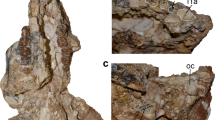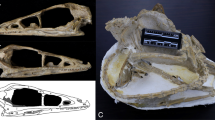Abstract
The debut of undoubted euprimates (primates of modern aspect1,2) was in the early Eocene, about 55 Myr ago. Since their first appearance, the earliest euprimates can be distinguished as Cantius, Donrussellia and Teilhardina2,3,4. Nonetheless, the earliest euprimates are primarily known from isolated teeth or fragmentary jaws. Here we describe a partially preserved euprimate skull with nearly complete upper and lower dentition, which represents a new species of Teilhardina and constitutes the first discovery of the genus in Asia. The new species is from the upper section of Lingcha Formation, Hunan Province, China, with an estimated age of 54.97 Myr ago5. Morphology and phylogeny analyses reveal that the new species is the most primitive species of Teilhardina, positioned near the root of euprimate radiation. This discovery of the earliest euprimate skull known to date casts new light on the debate6,7,8,9,10,11,12 concerning the adaptive origin of euprimates, and suggests that the last common ancestor of euprimates was probably a small, diurnal, visually oriented predator.
This is a preview of subscription content, access via your institution
Access options
Subscribe to this journal
Receive 51 print issues and online access
$199.00 per year
only $3.90 per issue
Buy this article
- Purchase on Springer Link
- Instant access to full article PDF
Prices may be subject to local taxes which are calculated during checkout




Similar content being viewed by others
References
Simons, E. L. Primate Evolution: an Introduction to Man's Place in Nature (Macmillan, New York, 1972)
Szalay, F. S. & Delson, E. Evolutionary History of the Primates (Academic, London, 1979)
Rose, K. D., Godinot, M. & Bown, T. M. in Anthropoid Origins (eds Fleagle, J. G. & Kay, R. F.) 1–28 (Plenum, New York, 1994)
Fleagle, J. G. Primate Adaptation and Evolution 2nd edn (Academic, London, 1999)
Bowen, G. J. et al. Mammalian dispersal at the Paleocene/Eocene boundary. Science 295, 2062–2065 (2002)
Cartmill, M. in The Functional and Evolutionary Biology of Primates (ed. Tuttle, R.) 97–122 (Aldine Atherton, Chicago, 1972)
Heesy, C. P. & Ross, C. F. Evolution of activity patterns and chromatic vision in primates: morphometrics, genetics and cladistics. J. Hum. Evol. 40, 111–149 (2001)
Li, W.-H. Genetic systems of color vision in primates. Am. J. Phys. Anthropol. 30(suppl.), 318 (2000)
Tan, Y. & Li, W.-H. Trichromatic vision in prosimians. Nature 402, 36 (1999)
Surridge, A. K., Osorio, D. & Mundy, N. I. Evolution and selection of trichromatic vision in primates. Trends Ecol. Evol. 18, 198–205 (2003)
Bloch, J. I. & Boyer, D. M. Grasping primate origins. Science 298, 1606–1610 (2002)
Kirk, E. C., Cartmill, M., Kay, R. F. & Lemelin, P. Comment on “Grasping primate origins”. Science 300, 741 (2003)
Kay, R. F. & Cartmill, M. Cranial morphology and adaptations of Palaechthon nacimienti and other Paromomyidae (Plesiadapoidea? Primates), with a description of a new genus and species. J. Hum. Evol. 6, 19–53 (1977)
Martin, R. D. Primate Origins and Evolution: a Phylogenetic Reconstruction (Chapman and Hall, London, 1990)
Ravosa, M. J., Noble, V. E., Hylander, W. L., Johnson, K. R. & Kowalski, E. M. Masticatory stress, orbital orientation and the evolution of the primate postorbital bar. J. Hum. Evol. 38, 667–693 (2000)
Ross, C. F. Allometric and functional influences on primate orbit orientation and the origins of the Anthropoidea. J. Hum. Evol. 29, 201–227 (1995)
Godinot, M. et al. Nouvelles données sur les mammifères de Palette (Eocène inférieur, Provence). Münchner Geowiss. Abh. 10, 237–288 (1987)
Bown, T. M. & Rose, K. D. Patterns of dental evolution in Early Eocene Anaptomorphine primates (Omomyidae) from the Bighorn Basin, Wyoming. J. Paleontol. 61(s; supplement), 1–162 (1987)
Gunnell, G. F. & Rose, K. D. in The Primate Fossil Record (ed. Hartwig, W. C.) 45–82 (Cambridge Univ. Press, Cambridge, 2002)
Rose, K. D. & Bown, T. M. Additional fossil evidence on the differentiation of the earliest euprimates. Proc. Natl Acad. Sci. USA 88, 98–101 (1991)
Ross, C., Williams, B. A. & Kay, R. F. Phylogenetic analysis of anthropoid relationships. J. Hum. Evol. 35, 221–306 (1998)
Kay, R. F., Ross, C. & Williams, B. A. Anthropoid origins. Science 275, 797–804 (1997)
Kay, R. F. & Kirk, E. C. Osteological evidence for the evolution of activity pattern and visual acuity in primates. Am. J. Phys. Anthropol. 113, 235–262 (2000)
Kay, R. F. The functional adaptation of primate molar teeth. Am. J. Phys. Anthropol. 43, 195–216 (1975)
Gingerich, P. D. Early Cenozoic Omomyidae and the evolutionary history of Tarsiiform primates. J. Hum. Evol. 10, 345–374 (1981)
Williams, B. A. & Covert, H. H. New early Eocene anaptomorphine primate (Omomyidae) from the Washakie Basin, Wyoming, with comments on the phylogeny and paleobiology of anaptomorphines. Am. J. Phys. Anthropol. 93, 323–340 (1994)
Swofford, D. L. PAUP*. Phylogenetic Analysis Using Parsimony (*and Other Methods). Version 4 (Sinauer, Sunderland, 2000)
Kay, R. F. & Hiiemae, K. M. Jaw movement and tooth use in recent and fossil primates. Am. J. Phys. Anthropol. 40, 227–256 (1974)
Maddison, W. P. & Maddison, D. R. MacClade: Analysis of Phylogeny and Character Evolution, Version 3.0 (Sinauer, Sunderland, 1992)
Covert, H. H. in Creatures of the Dark: The Nocturnal Prosimians (eds Alterman, L., Doyle, G. A. & Izard, M. K.) 495–509 (Plenum, New York, 1995)
Acknowledgements
We thank S. Xie for fossil preparation. We are grateful to J. Meng for comments on drafts of this manuscript, R. Kay for providing his published data and for suggestions, and K. C. Beard of for discussions. This research is funded by the National Natural Science Foundation of China, the Major Basic Research Project of Ministry of Sciences and Technology, China, and the Chinese Academy of Sciences.
Author information
Authors and Affiliations
Corresponding author
Ethics declarations
Competing interests
The authors declare that they have no competing financial interests.
Supplementary information
41586_2004_BFnature02126_MOESM1_ESM.pdf
Supplementary Information 1: The specimen measurements, statistic analyses for activity pattern reconstruction, and cladistic analyses. (PDF 762 kb)
Rights and permissions
About this article
Cite this article
Ni, X., Wang, Y., Hu, Y. et al. A euprimate skull from the early Eocene of China. Nature 427, 65–68 (2004). https://doi.org/10.1038/nature02126
Received:
Accepted:
Issue Date:
DOI: https://doi.org/10.1038/nature02126
This article is cited by
-
Modules and Mosaics in the Evolution of the Tetonius – Pseudotetonius Dentition
Journal of Mammalian Evolution (2020)
-
Rethinking the Origin of Primates by Reconstructing Their Diel Activity Patterns Using Genetics and Morphology
Scientific Reports (2017)
-
The oldest known primate skeleton and early haplorhine evolution
Nature (2013)
Comments
By submitting a comment you agree to abide by our Terms and Community Guidelines. If you find something abusive or that does not comply with our terms or guidelines please flag it as inappropriate.



